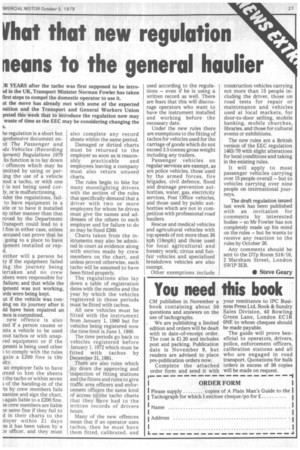That that new regulation means to the general haulier
Page 29

If you've noticed an error in this article please click here to report it so we can fix it.
JR YEARS after the tacho was first supposed to be introed in the UK, Transport Minister Norman Fowler has taken first steps to compel the domestic operator to use it.
at the move has already met with some of the expected osition and the Transport and General Workers Union ;ested this week that to introduce the regulation now may waste of time as the EEC may be considering changing the S.
he regulation is a short but iprehensive document en.1c1 The Passenger and Ids Vehicles (Recording ipment) Regulations .1979 its function is to lay down r offences which may be imitted by using or per:ing the use of a vehicle lout a tacho, or with one t is not being used corly, or is malfunctioning. nder the regulations, failto have equipment in a icle or to have it installed ny other manner than that roved by the Department Transport could lead to a fine in either case, unless accused can prove that he going to a place to have ipment installed or repd.
either will a person be ty if the equipment failed ing the journey being lertaken and no crew nbers were responsible for failure; and that while the ipment was not working, >rds were being kept.
ut if the vehicle was conling on its journey after it Lid have been repaired an nice is committed.
new offence is also Lted if a person causes or nits a vehicle to be used lout tachos or with unapved equipment or if the ,pment is being used other to comply with the rules gain a £200 fine is the alty.
an employer fails to have irned to him the sheets the tacho or within seven 3 of the handing-in of the -ts by crew members fails icamine. and sign the chart, again liable to a £200 fine. ie crew members are liable le same fine if they fail to d in their charts to the )loyer within 21 days !ss it has been taken by a e officer, and they must also complete any record sheets within the same period.
Damaged or dirtied charts must be returned to the employer as soon as is reason ably practicable and employees leaving a company must also return unused charts.
The rules begin to bite for many moonlighting drivers with the section of the rules that specifically demand that a driver with two or more employers for whom he drives must give the names and addresses of the others to each employer and for failure to do so may be fined £200.
Charts taken from the instruments may also be admitted in court as evidence along with entries made by crew members on the chart, and unless proved otherwise, each tacho will be assumed to have been fitted properly.
The regulations also lay down a table of registration dates with the months and the year by which the vehicles registered in those periods must be fitted with tachos.
All new vehicles must be fitted with the instrument from January 1, 1980 but for vehicles being registered now the time limit is June 1, 1980.
The time periods go back to vehicles registered before January 1, 1972 which must be fitted with tachos by December 31, 1981.
There are also rules which lay down the approving and inspection of fitting stations and the fitters and rules to give traffic area officers and enforcement officers the same kind of access to the tacho charts that they have had to the written records of drivers hours.
Many of the new offences mean that if an operator uses tachos, then he must 'have them fitted, calibrated, and used according to the regulations — even if he is using a written record as well. There are fears that this will discourage operators who want to have the instrument installed and working before the necessary date.
Under the new rules there are exemptions to the fitting of tachos for vehicles used for the carriage of goods which do not exceed 3.5 tonnes gross weight including any trailers.
Passenger vehicles on regular services are exempt, as are police vehicles, those used by the armed forces, fire brigades, civil defence, flood and drainage prevention authorities, water, gas, electricity services, Post Office vehicles, and those used by public authorities which are not in competition with professional road hauliers.
Rescue and medical vehicles and agricultural vehicles with top speeds of not more than 30 kph (18mph) and those used for local agricultural and forestry work; circus and funfair vehicles and specialised breakdown vehicles are also exempt.
Other exemptions include construction vehicles carrying not more than 15 people including the driver, those on road tests for repair or maintenance and vehicles used at local markets, for door-to-door selling, mobile banking, mobile churches, libraries, and those for cultural events or exhibitions.
The new rules are a British version of the EEC regulation 1463/70 with slight alterations for local conditions and taking in the existing rules.
It will apply to most passenger vehicles carrying over 15 people overall — but to vehicles carrying over nine people on international journeys.
The draft regulation issued last week has been published with an invitation for comments by interested bodies — so Mr Fowler has not completely made up his mind on the rules — but he wants to receive any reaction to the rules by October 26.
Any comments should be sent to the DTp Room S18/16, 2 Marsham Street, London SW1P 3EB.
• Steve Geary




























































































































































